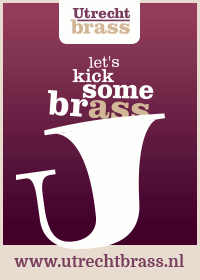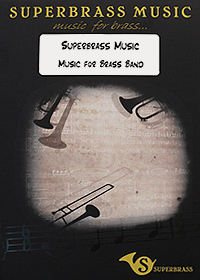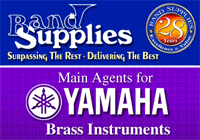Malcolm Arnold Celebration Concert
30-Sep-2004Grimethorpe Colliery (UK) Band
Conductor: Elgar Howarth
Queen Elizabeth Hall
Monday 27th September 2004
Grimethorpe's concert at the Queen Elizabeth Hall on London's South Bank was the fourth and final event in a "Malcolm Arnold Celebration" organised by the London Philharmonic Orchestra, with whom the composer had played trumpet for a number of years. Arranged to coincide with the premiere screening of
Tony Palmer's film "Toward the Unknown Region, Malcolm Arnold, - A Story of Survival", other events had included a study day and a concert by the LPO featuring Arnold's orchestral music. A full hall included many who had attended all the other events, together with brass band enthusiasts, including such personalities as Richard Evans, Don Lusher, Melvin White and Stephen Cobb, one of whose sons was sitting amongst the solo cornets.
Grimethorpe opened the programme with Ray Farr's arrangement of the "Four Scottish Dances", and it was clear from the confident start that they were on top form. The characteristic scotch snap of the "Strathspey" and the somewhat spiky figures pointed to Arnold's joviality, whilst the swells in the accompaniment were very telling. Following audience applause at the end of the first dance, the two euphoniums set off at a cracking pace before Mark Frost took on the cameo role of the drunk in the middle section. The following "Allegretto", a pastoral interlude, offered the first of many opportunities for Richard Marshall to show why he is so highly regarded. Here Arnold's melancholia came to the fore, with a typically attractive melody with a poignancy of its own, before the final "Con Brio" of the reel raced along, showing Arnold at his most boisterous.
Elgar Howarth explained to the audience that Sir Malcolm Arnold was unable to attend due to ill health, and then outlined the thinking behind the programme, which juxtaposed Arnold's works for brass with those by some of his contemporaries. The first of these was William Walton's "The First Shoot", written for a ballet in 1936, lost for many years, and then resurfacing just when Elgar Howarth had asked him for a work for
Grimethorpe. Based around a pheasant shoot, the band version received its premiere at the Proms in 1981 and shows Walton at his most skittish. With its jazz-tinged influences, it calls for a light touch and a suitably
"tongue-in-cheek" approach. The band each in turn made the most of their emerging phrases, with some effective glissandi from the trombones and the xylophone playing a prominent role. Of particular note was the duet between Sandy Smith on horn and the flugel, played on this occasion by Helen Fox. Also, the melody alternating between flugel and soprano was handled very smoothly.
The audience was still applauding when the band commenced the "Siciliano" from "Little Suite No 1". Possibly the most frequently played of all of Arnold's music for brass, the apparently simple melody is a little gem and was treated with the utmost delicacy, leaning slightly on the notes and with the answering phrases well matched.
Arnold had a particular affinity with Cornwall, and the "Four Cornish Dances" are deservedly popular. The band sound at the opening made a good imitation of the French horn tone of the original orchestral version, and the constantly shifting accents grabbed ones attention. The second movement, in Arnold's own words depicting the "strange and sad beauty" of the ruined workings of tin and copper mines, makes much use of mutes and percussion effects to contribute to the somewhat eerie effects, with the haunting use of tubular bells, and the vibraphone adding to the sense of mystery. The hymn-like third section gradually grew in intensity, led by the solid tread of the basses as if portraying an approaching procession, with tambourine prominent, and a carefully placed final "Amen". The fourth movement sees Arnold again in celebratory mood and the basses again had the chance to shine as they joined in the general rejoicing.
Elgar Howarth explained how Gilbert Vinter's "Spectrum" had broken new ground with its extensive use of mutes and new timbres found in developing the harmonic writing for band. Vinter had been a professional bassoonist earlier in his career, and he had also played for a while with the London Philharmonic Orchestra. Having recorded the work on the first volume of their History of Brass Music the band seemed very comfortable with the music, with clean tonguing and very precise playing, and well balanced harmonies. Much was made of the contrasts between forceful chords and the delicate interplay, such as that between cornet and trombone. The unison figures were particularly impressive and it made for a rousing conclusion to the first part of the programme.
When the band took the stage after the interval, the Principal Cornet and Rep seats were empty. The reason why was soon apparent as the sounds of Arnold's "Fanfare for Louis" were heard emanating from the back of the stage. Written in tribute to Louis Armstrong, Elgar Howarth had been one of the two trumpeters who gave its first performance and, played on this occasion by Richard Marshall and Lee Rigg, it made for an unusual but effective opener.
Herbert Howell's "Pageantry", written for the British Open in 1934, drew some suitably majestic playing in the opening section, "King's Herald", whilst Sandy Smith's horn was again to the fore in the central "Cortege". Note values were meticulously observed, and the playing was intense and full-bodied, with what seemed like a particularly long pause before the final movement. Responding to the solo cornet throwing down the gauntlet in "Jousts", this movement brought out the best from the band, with some good work from the trombones especially.
Arnold's music was often influenced by folk songs and Elgar Howarth had arranged a group of five to be featured in the concert. With three rather boisterous, humorous numbers - "Soldier, soldier won't you marry me", "Oh dear, what can the matter be" and "Bobby Shaftoe" - framing two more reflective songs - "Golden slumbers" and "Waley-Waley" - the accompaniments were very lightly scored with a deal of humour. It was certainly very testing for the players, as it would have been so easy to overpower the soloist, soprano Christine Buffle. As it was, with her bubbly personality adding much character, most of the words carried over the band quite clearly, with the louder sections of the accompaniment reserved for interludes between her phrases. Such writing could easily sound fragmented in less expert hands, but the runs, fanfares and galumphing basses all seemed to fall into place just right. Occasionally, particularly in the two slower songs, the accompaniment came down to just one or two players, with horn again being featured effectively. "Bobby Shaftoe" included references throughout to the "Sailor's Hornpipe", as well as some whistling from the band.
Arnold's first set of "English Dances" were written in 1950 following a challenge to a number of composers that they should write some companion pieces to Dvorak's "Slavonic Dances". Full of references to traditional English life and values, they offered another opportunity for the band to enter into the spirit of celebration, whilst the third movement returns to Arnold's more melancholy mood. The final "Allegro Risoluto" seems to foreshadow "The Padstow Lifeboat", written some eighteen years late, and there are also echoes of Holst's "Jupiter".
Arnold's "Fantasy for Brass Band" was commissioned for the National Brass Band Championship in 1974. Following a finely balanced opening, with exemplary runs in the bottom half of the band, Helen Fox's flugel sang out clearly. The quartet section when the trombones joined her also came across very well. The "Dance", beginning innocently enough, led off into one of Arnold's more disconcerting sections, with oddly shifting chords and disruptive rhythms, but all held together tightly by the conductor. Following the "Elegy", featuring cornet and euphonium, the "Scherzo" called for some very tidy tonguing throughout the band. Played as well as this, it was an exhilerating experience, and left the audience hoping for more.
Elgar Howarth remarked that, if they were footballers, they would be going off to recuperate, but as they were a band of Yorkshiremen there would indeed be an encore - the last section of the "Little Suite No 1". It proved an ideal end to the evening, exuberant and yet dignified, underlining the quality of Arnold's music, even when writing for less experienced players. The band had shown considerable stamina in tackling a heavy programme, with little chance to relax in between items, and it was encouraging that a band was invited to take part in such a prestigious celebration. The only personal disappointment was the absence from the programme of Elgar Howarth's "Songs for BL", listed in the initial feature in "British Bandsman", but it may have ben decided it would have been out of place and drawn attention away from the central focus on Malcolm Arnold's music.
Peter Bale









